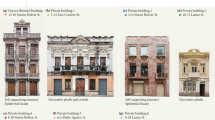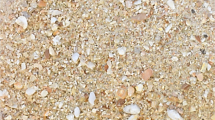Abstract
This study investigated the mineralogical, chemical, physical, mechanical, durability–hygrothermal, thermal shock properties, and economic aspects of the Kandira stone, one of the well-known natural building stones, commonly used in many historical structures in the Marmara and Thrace regions. Especially, it has been preferred to Malta stone in historical structures in Istanbul due to economic reasons at the beginning of the 1900s. A similar appearance and lithology with Malta stone and closeness of the Kandıra stone to İstanbul made it attractive to be used as natural building stone in historical monuments and new structures. The mean physico-mechanical properties of Kandira stone yielded 2.24 g/cm3 apparent density, 2.72 specific gravity, 19.21% total porosity, 5.8% water absorption by weight, 48 MPa compressive strength, 11.4 MPa bending strength. In terms of durability properties, Kandira stone has high resistance to aging by CaCl salt mist and no or low resistance to SO2 aging in a humid environment. Also, the freeze–thaw test of Kandira stone yielded an exceptionally low mass loss (0.11%) indicating that the stone is resistant to freeze–thaw effect. Thermal shock tests indicated that Kandira stone is mainly resistant to thermal shock cycles. Economically, the calculated probable reserve of Kandira stone resulted in 40.8 × 106 tons of material and the potential economic value based on the probable reserve is calculated around 54.672 × 109 TL (approximately €7.2B). In conclusion, this study defined the petrographic, geomechanical, durability–hygrothermal and thermal shock properties essential for the use of Kandira stone as building stone and restoration material.







Similar content being viewed by others
Data availability
Data used in the manuscript were obtained from an accredited natural building stone laboratory (AKU-NSL) and are given through the Tables in the manuscript.
References
Anon. (1979s) Classification of rocks and soils for engineering geological mapping. Part 1-rock and soil materials. Bull Int Assoc Eng Geol 19:364–371
Arman H, Ramazanoglu S, Akinci A (2007) Mechanical and physical properties of the Kandira stone, Kandira, Turkey. Bull Eng Geol Environ 66(3):331–333
Arman H, Ramazanoglu S, Goktepe F, Ozsoy EA, Yilmaz G (2010) Importance of geological and geotechnical properties of Kandıra stone in civil engineering applications. In: Proceedings of the European rock mechanics symposium (Eurock 2010) 831-834, Lausanne, Switzerland
AS 4586 (2013) Slip resistance classification of new pedestrian surface materials. Standards Australia, Sydney, New South Wales
ASTM D 5550-06 (2009) Standard test method for specific gravity of soil solids by gas pycnometer. ASTM International, West Conshohocken, PA
Aydın Ipekci C, Aydın EO (2017) Local building materials resources: Kocaeli. Int Refereed J Des Arch 12:98–129. https://doi.org/10.17365/TMD.2017.3.4
Aydındag A, Erkanol D (2011) Kandıra Taşı’nın (Kocaeli) Yapı Taşı Olarak Kullanılabilirliğinin Araştırılması. MTA Maden Etüt ve Arama Dairesi Başkanlığı Teknik Rapor, Ankara (in Turkish)
Barton N (1978) Suggested methods for the quantitative description of discontinuities in rock masses. International Society of Rock Mechanics Commission on Standardization of Laboratory and Field Tests. Int J Rock Mech Min Sci Geomech Abstr 15:319–368
Bell FG (1993) Durability of carbonate rock as building stone with comments on its preservation. Environ Geol 21(4):187–200. https://doi.org/10.1007/BF00775905
Blows JF, Carey PJ, Poole AB (2003) Preliminary investigations into Caen Stone in the UK: its use, weathering and comparison with repair stone. Build Environ 38(9–10):1143–1149
Bozkurtoglu E, Mert E (2012) Strength and slake durability relation of Kandıra Stone. Kocaeli-Turkey. J Appl Earth Sci 11(1):30–50
Celik MY (2003) Types and usage areas of the decorative natural building stones. Sci Min J 42(1):3–15
Cobanoglu I, Celik SB (2017) Assessments on the usability of wide wheel (Capon) test as a reference abrasion test method for building stones. Constr Build Mater 151:319–330. https://doi.org/10.1016/j.conbuildmat.2017.06.045
Coruk O, Karakas A, Ozer C, Mert E (2001) Production of engineering geological maps for the Izmit and vicinity areas by using GIS. Kocaeli University Scientific Research Project, Kocaeli, pp 99–119
Coskun G, Sarıısık G, Sarıısık A (2017) Slip safety risk analysis of surface properties using the coefficients of friction of rocks. Int J Occup Saf Ergon 25(3):443–457. https://doi.org/10.1080/10803548.2017.1395594
Dal M, Angi SO, Eyüboğlu R (2007) İstanbuldaki bazı tarihi yapılarda kullanılan yapı taşlarının kökenleri ve getirildikleri yerler. Mimarlıkta Malzeme Dergisi 4:72–76 (in Turkish)
Deere DU, Miller RP (1966) Engineering classifications and index properties of intact rock. Technical Report No: AFWL-TR 65-116, University of Illinois, USA, p 300
Ellul M (2010) Malta limestone goes to Europe: use of Malta stone outside Malta. The Malta Historical Society. http://maltahistory.eu5.net/60/60_25.html
Folk RL (1968) Petrology of sedimentary rocks. Hemphill Publishing Company, Austin, p 170
Gatt PA (2006) Model of limestone weathering and damage in masonry: Sedimentological and geotechnical controls in the Globigerina Limestone Formation (Miocene) of Malta. J Malta Chamb Sci Xjenza 11:30–39
Gedik İ, Pehlivan Ş, Timur E, Duru M (2005) 1:50000 ölçekli Türkiye jeoloji haritaları No:13. İstanbul F23c paftası, Maden Tetkik ve Arama Genel Müdürlüğü Jeoloji Etütleri Dairesi (in Turkish)
Hajpa´l M, Török A (2004) Mineralogical and color changes of quartz sandstones by heat. Environ Geol 46:311–322. https://doi.org/10.1007/s00254-004-1034-z
HB 198 (2014) Guide to the specification and testing of slip resistance of pedestrian surfaces. Handbook, Standards Australia, Sydney, New South Wales
ISRM (1981) Rock characterization, testing and monitoring. In: Brown ET (ed) 1981. International Society for Rock Mechanics (ISRM) Suggested Methods. Pergamon, Oxford, p 211
Kahraman N, Arıkan R (2016) Başbakanlık Osmanlı Arşivi Belgelerinde Karamürsel Taşı ve İzmit Bölgesi Diğer Taş Ocakları. Uluslararası Kara Mürsel Alp ve Kocaeli Tarihi Sempozyumu II Kocaeli c III:1863–1876 (in Turkish)
Kock TD, Turmel A, Fronteau G, Cnudde V (2017) Rock fabric heterogeneity and its influence on the petrophysical properties of a building limestone: Lede Stone (Belgium) as an example. Eng Geol 216(1):31–41
Moralı G (2019) Determination of building stone properties and economic potential of Kocaeli Kandıra Stone. M.Sc. Dissertation, Kocaeli University Graduate School of Natural and Applied Sciences
Ozkan FS (2018) Investigation of the use of limestones as a natural building block in Unlupınar (Kelkit-Gumushane) region. Undergr Resour J 7(13):37–62
Rickman D, Street KW (2008) Some expected mechanical characteristics of lunar dust: a geological view. In: Proceedings of the space technology and applications international forum, Albuquerque, NM
Rothert E, Eggers T, Cassar J, Ruedrich J, Fitzner B, Siegesmund S (2007) Stone properties and weathering induced by salt crystallization of Maltese Globigerina Limestone. Building stone decay: from diagnosis to conservation. Geol Soc Lond Spec Publ 271:189–198. https://doi.org/10.1144/GSL.SP.2007.271.01.19
Selim HH, Karakas A, Coruk O (2019) Investigation of engineering properties for usability of Lefke stone (Osmaneli/Bilecik) as building stone. Bull Eng Geol Environ 78:6047–6059. https://doi.org/10.1007/s10064-019-01520-3
Siegesmund S, Dürrast H (2011) Physical and mechanical properties of rocks. In: Siegesmund S, Snethlage R (eds) Stone in architecture. Springer, Berlin. https://doi.org/10.1007/978-3-642-14475-2_3
Siegesmund S, Ullemeyer K, Weiss T, Tschegg EK (2000) Physical weathering of marbles caused by anisotropic thermal expansion. Int J Earth Sci 89:170–182. https://doi.org/10.1007/s005310050324
Snethlage R (2005) Leitfaden zur Steinkonservierung. Fraunhofer IRB Verlag, p 347
Taghipour M, Nikudel MR, Farhadian MB (2016) Engineering properties, and durability of limestones used in Persepolis complex, Iran, against acid solutions. Bull Eng Geol Environ 75:967–978. https://doi.org/10.1007/s10064-015-0821-y
Török Á, Přikryl R (2010) Current methods and future trends in testing, durability analyses and provenance studies of natural stones used in historical monuments. Eng Geol 115(3–4):139–142. https://doi.org/10.1016/j.enggeo.2010.07.003
TS 11137 (1993) Limestone - used for building and facing. Turkish Standards Institution, Ankara
TS 699 (2009) Methods of testing for natural building stones. Turkish Standards Institution, Ankara
TS EN 12370 (2001) Determination of resistance to salt crystallization. Turkish Standards Institution, Ankara
TS EN 12371 (2011) Determination of frost resistance. Turkish Standards Institution, Ankara
TS EN 12372 (2013) Determination of flexural strength under a concentrated load. Turkish Standards Institution, Ankara
TS EN 12407 (2013) Natural stone test methods-petrographic examination. Turkish Standards Institution, Ankara
TS EN 13161 (2014) Determination of flexural strength under constant moment. Turkish Standards Institution, Ankara
TS EN 13364 (2003) Determination of breaking load at dowel hole. Turkish Standards Institution, Ankara
TS EN 13755 (2014) Determination of water absorption at atmospheric pressure. Turkish Standards Institution, Ankara
TS EN 13919 (2004) Determination of resistance to ageing by SO2 action in the presence of humidity. Turkish Standards Institution, Ankara
TS EN 14066 (2015) Natural stone test methods-determination of resistance to ageing by thermal shock. Turkish Standards Institution, Ankara
TS EN 14147 (2004) Natural stone test methods-determination of resistance to ageing by salt mist. Turkish Standards Institution, Ankara, p 10
TS EN 14157 (2017) Determination of the abrasion resistance. Turkish Standards Institution, Ankara
TS EN 14158 (2004) Natural stone test methods-determination of rupture energy. Turkish Standards Institution, Ankara
TS EN 14205 (2004) Natural stone test methods-determination of Knoop hardness. Turkish Standards Institution, Ankara
TS EN 14231 (2004) Determination of the slip resistance by means of the pendulum tester. Turkish Standards Institution, Ankara
TS EN 14579 (2015) Determination of sound speed propagation. Turkish Standards Institution, Ankara
TS EN 15309 (2008) Determination of elemental composition by X-Ray fluorescence. Turkish Standards Institution, Ankara
TS EN 1925 (2000) Determination of water absorption coefficient by capillarity. Turkish Standards Institution, Ankara
TS EN 1926 (2000) Determination of compressive strength. Turkish Standards Institution, Ankara
TS EN 1936 (2001) Determination of real density and apparent density and of total and open porosity. Turkish Standards Institution, Ankara
TS EN ISO 12572 (2016) Hygrothermal performance of building materials and products-determination of water vapour transmission properties-cup method. Turkish Standards Institution, Ankara
Uğuryol D (2020) Evaluation of preservation problems of the historical gardens and their architectural elements considering the palaces and pavilions in Istanbul. Middle East Tech Univ J Fac Arch 37(1):225–252. https://doi.org/10.4305/METU.JFA.2020.1.4
Unal M, Altunok E (2019) Determination of water absorption properties of natural building stones and their relation to porosity. Eng Sci 14(1):39–45. https://dergipark.org.tr/tr/pub/nwsaeng/issue/42900/487872
Yagiz S (2009) Bascesme formation (Bascesme-Denizli) usability of dolomitic limestone member as building stone. Suleyman Demirel Univ J Inst Sci 13(3):265–270
Acknowledgments
The authors would like to thank to Kocaeli University BAP Coordination Unit for providing financial support to the 2019/020 BAP project, which provided the basic data essential for the preparation of this article. Also, a sincere gratitude is extended to AKU-NSL and Gunay Acıkgoz for his assistance during the fieldwork.
Funding
The study was supported by the Kocaeli University Scientific Research Projects (BAP) Coordination Unit through a research project (BAP project #2019/020).
Author information
Authors and Affiliations
Contributions
Each author has made the necessary contribution for the subjects related to her/his field.
Corresponding author
Ethics declarations
Conflict of interest
Not applicable.
Additional information
Publisher's Note
Springer Nature remains neutral with regard to jurisdictional claims in published maps and institutional affiliations.
Rights and permissions
About this article
Cite this article
Karakaş, A., Morali, G., Coruk, Ö. et al. Geomechanical, durability–hygrothermal and thermal shock properties of Kocaeli Kandira stone used as building stone in historical structures. Environ Earth Sci 80, 130 (2021). https://doi.org/10.1007/s12665-021-09426-8
Received:
Accepted:
Published:
DOI: https://doi.org/10.1007/s12665-021-09426-8




